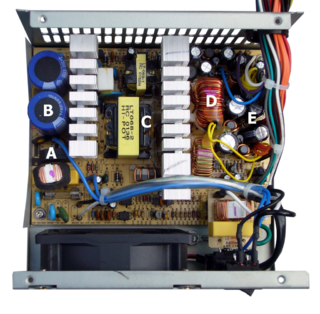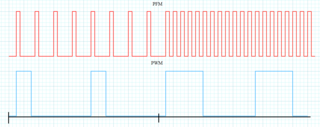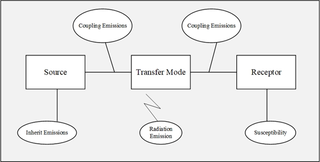
Electromagnetic compatibility (EMC) is the ability of electrical equipment and systems to function acceptably in their electromagnetic environment, by limiting the unintentional generation, propagation and reception of electromagnetic energy which may cause unwanted effects such as electromagnetic interference (EMI) or even physical damage to operational equipment. The goal of EMC is the correct operation of different equipment in a common electromagnetic environment. It is also the name given to the associated branch of electrical engineering.

In telecommunication, especially radio communication, spread spectrum are techniques by which a signal generated with a particular bandwidth is deliberately spread in the frequency domain over a wider frequency band. Spread-spectrum techniques are used for the establishment of secure communications, increasing resistance to natural interference, noise, and jamming, to prevent detection, to limit power flux density, and to enable multiple-access communications.

Pulse-width modulation (PWM), also known as pulse-duration modulation (PDM) or pulse-length modulation (PLM), is any method of representing a signal as a rectangular wave with a varying duty cycle.

A power inverter, inverter, or invertor is a power electronic device or circuitry that changes direct current (DC) to alternating current (AC). The resulting AC frequency obtained depends on the particular device employed. Inverters do the opposite of rectifiers which were originally large electromechanical devices converting AC to DC.

A switched-mode power supply (SMPS), also called switching-mode power supply, switch-mode power supply, switched power supply, or simply switcher, is an electronic power supply that incorporates a switching regulator to convert electrical power efficiently.
This is an index of articles relating to electronics and electricity or natural electricity and things that run on electricity and things that use or conduct electricity.

Power electronics is the application of electronics to the control and conversion of electric power.
PWM rectifier is an AC to DC power converter, that is implemented using forced commutated power electronic semiconductor switches. Conventional PWM converters are used for wind turbines that have a permanent-magnet alternator.

Electromagnetic interference (EMI), also called radio-frequency interference (RFI) when in the radio frequency spectrum, is a disturbance generated by an external source that affects an electrical circuit by electromagnetic induction, electrostatic coupling, or conduction. The disturbance may degrade the performance of the circuit or even stop it from functioning. In the case of a data path, these effects can range from an increase in error rate to a total loss of the data. Both human-made and natural sources generate changing electrical currents and voltages that can cause EMI: ignition systems, cellular network of mobile phones, lightning, solar flares, and auroras. EMI frequently affects AM radios. It can also affect mobile phones, FM radios, and televisions, as well as observations for radio astronomy and atmospheric science.

An HVDC converter station is a specialised type of substation which forms the terminal equipment for a high-voltage direct current (HVDC) transmission line. It converts direct current to alternating current or the reverse. In addition to the converter, the station usually contains:

A variable-frequency drive is a type of AC motor drive that controls speed and torque by varying the frequency of the input electricity. Depending on its topology, it controls the associated voltage or current variation.

A class-D amplifier or switching amplifier is an electronic amplifier in which the amplifying devices operate as electronic switches, and not as linear gain devices as in other amplifiers. They operate by rapidly switching back and forth between the supply rails, using pulse-width modulation, pulse-density modulation, or related techniques to produce a pulse train output. A simple low-pass filter may be used to attenuate their high-frequency content to provide analog output current and voltage. Little energy is dissipated in the amplifying transistors because they are always either fully on or fully off, so efficiency can exceed 90%.

Pulse-frequency modulation (PFM) is a modulation method for representing an analog signal using only two levels. It is analogous to pulse-width modulation (PWM), in which the magnitude of an analog signal is encoded in the duty cycle of a square wave. Unlike PWM, in which the width of square pulses is varied at a constant frequency, PFM fixes the width of square pulses while varying the frequency. In other words, the frequency of the pulse train is varied in accordance with the instantaneous amplitude of the modulating signal at sampling intervals. The amplitude and width of the pulses are kept constant.
Space vector modulation (SVM) is an algorithm for the control of pulse-width modulation (PWM), invented by Gerhard Pfaff, Alois Weschta, and Albert Wick in 1982. It is used for the creation of alternating current (AC) waveforms; most commonly to drive 3 phase AC powered motors at varying speeds from DC using multiple class-D amplifiers. There are variations of SVM that result in different quality and computational requirements. One active area of development is in the reduction of total harmonic distortion (THD) created by the rapid switching inherent to these algorithms.

The Vienna Rectifier is a pulse-width modulation rectifier, invented in 1993 by Johann W. Kolar at TU Wien.
Stochastic Signal Density Modulation (SSDM) is a novel power modulation technique primarily used for LED power control. The information is encoded - or the power level is set - using pulses that have pseudo-random widths. The pulses are produced so that, on average, the produced signal will have the desired ratio between high and low states. The main benefit of using SSDM over, for example, Pulse-width modulation (PWM), which is usually the preferred method for controlling LED power, is reduced electromagnetic interference. Figure 1 illustrates a SSDM signal and demonstrates how the average signal density approaches desired value. The pseudo-random pulses in the signal are visible.

Switching Noise Jitter (SNJ) is the aggregation of variability of noise events in the time-domain on the supply bias of an electronic system, in particular with a voltage regulated supply bias incorporated with closed-loop (feedback) control, for instance, SMPS. SNJ is measurable using real-time spectral histogram analysis and expressed as a rate of occurrence in percentage. The existence of SNJ was firstly demonstrated and termed by TransSiP Inc in 2016 and 2017 at the Applied Power Electronics Conference (APEC), and reviewed with experts at Tektronix prior to be featured as a case study published by Tektronix. The discovery of SNJ was also featured in multiple articles published by Planet Analog magazine and EDN Network. Difficult to filter using conventional LC networks due to variability in both time and frequency domains, SNJ can introduce random errors in analog to digital conversion, affecting both data integrity and system performance in digital communications and location-based services

Conducted emissions are the effects in power quality that occur via electrical and magnetic coupling, electronic switch of semiconductor devices, which form a part of electromagnetic compatibility issues in electrical engineering. These affect the ability of all interconnected system devices in the electromagnetic environment, by restricting or limiting their intentional generation, propagation and reception of electromagnetic energy.
Switching Control Techniques address electromagnetic interference (EMI) mitigation on power electronics (PE). The design of power electronics involves overcoming three key challenges:
- power losses
- EMI
- harmonics

Low-frequency electromagnetic compatibility is a specific field in the domain of electromagnetic compatibility (EMC) and power quality (PQ), which deals with electromagnetic interference phenomena in the frequency range between 2 kHz and 150 kHz. It is a special frequency range because it does not fit in the PQ problems, with range of up to 2 kHz, where relative levels of voltage and current can have massive impact on efficiency and integrity of electric systems, and neither in the conducted EMC range, which starts at 150 kHz and influences mainly informational systems, and already too far from radiated EMC range, which starts at 30 MHz and goes up to 1 GHz.


















